Here, we will share the most popular saltwater fish. Saltwater fish are some of the most popular pets in the world. Many people enjoy the beauty and grace of these amazing creatures. Saltwater fish come in various shapes, sizes, and colors. They can be found in all corners of the world’s oceans.
Some of the most popular saltwater fish include clownfish, angelfish, and tangs. These fish are all very colorful and beautiful. They are also relatively easy to care for, which makes them ideal pets for many people.
Saltwater fish are also some of the most relaxing pets to keep. They are very peaceful and can help to create a calm atmosphere in your home. If you are looking for a pet that is low-maintenance and will not require a lot of your time, then a saltwater fish may be the perfect choice for you.
We have rounded up the most popular species, from colorful small beginner fish to larger species more suited to experts.
These fishes are:
- Clownfish
- Green Chromis
- Wrasses
- Pajama Cardinalfish
- Damselfish
- Blennies
- Coral Beauties
- Tangs
- Diamond Watchman Goby
- Butterflyfish
- Orange Spotted Goby
- Firefish
- Dottyback
- Mollies
- Royal Gramma
- Flame Hawkfish
- Triggerfish
Table of Contents
- Clownfish Appearance
- Clownfish Care Guide
- Green Chromis Appearance
- Green ChromisCare Guide
- Wrasses Appearance
- Wrasse Care Guide
- Pajama Cardinalfish Appearance
- Pajama Cardinalfish Care Guide
- Damselfish Appearance
- Damselfish Care Guide
- Blenny Summary
- Blenny Care Guide
- Coral Beauty Summary
- Coral Beauty Care Level
- Yellow Tang Summary
- Yellow Tang Care Guide
- Diamond Watchman Goby Summary
- Diamond Watchman Goby Care
- Copperband Butterflyfish Appearance
- Copperband Butterflyfish Care Guide
- Orange Spotted Goby
- Orange Spotted Goby Care Guide
- Firefish Summary
- Firefish Care Guide
- Dottyback Summary
- Dottyback Care Level
- Mollie Summary
- Mollie Care Guide
- Royal Gramma Summary
- Royal Gramma Care Guide
- Flame Hawkfish
- Flame Hawkfish Care Guide
- Triggerfish Summary
- Triggerfish Care Guide
- Summary
Clownfish Appearance
Clownfish are one of the most popular fish in saltwater aquariums. They are relatively easy to care for and are very hardy. Clownfish come in various colors and patterns and can range in size from 2 inches to 6 inches.
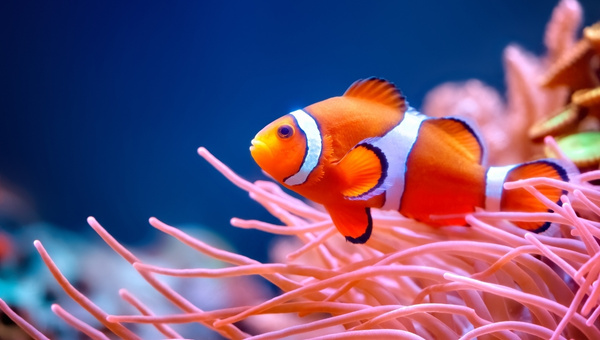
They will do better in aquariums if there are anemones for them to live in.
Availability
Clownfish are widely available and relatively inexpensive and can be found at most pet stores. The price will vary depending on the size, color, and pattern of the fish.
Check Clown Loach Care: Appearance, Tank Mates, Lifespan, Breeding & All
Following are some popular types of clownfish:
- Ocellaris Clownfish: The ocellaris clownfish is one of the most popular types of clownfish. They are also known as false percula clownfish. They are orange with white stripes and can grow about 4 inches long. They are very hardy fish and do well in captivity.
- Maroon Clownfish: The maroon clownfish is another popular type of clownfish. They are red with white stripes and can grow about 6 inches long. They are very hardy fish and do well in captivity.
- Tomato Clownfish: The tomato clownfish is another popular type of clownfish. They are orange with white stripes and can grow about 4 inches long. They are very hardy fish and do well in captivity.
- Nemo: Nemo is an ocellaris clownfish and is one of the most popular fish in saltwater aquariums. He is orange with white stripes and grows to be about 4 inches long. He is very hardy and does well in captivity.
Clownfish Breeding
Clownfish are relatively easy to breed in captivity. They are Egg scatterers and lay their eggs on the substrate or live rock. The eggs will hatch in about 10 days, and the fry will be free-swimming a few days later.
The fry should be fed live baby brine shrimp or microworms until they are large enough to eat flake food.
Clownfish Care Guide
Clownfish are relatively easy to care for and add to any saltwater aquarium. They are hardy fish and can tolerate a wide range of water conditions. It is important to provide them with anemones, as they will do better in captivity if they have them.
Also, check Clown Pleco 101:Care, Diet, Lifespan, Food & Diet, Breeding & All
Clownfish Tankmates
Clownfish are peaceful fish and get along well with other saltwater fish. Some good tank mates for clownfish include damselfish, dottybacks, wrasses, and certain tangs. It is important to avoid fish, known as bullies or nippers, as they can stress out the clownfish and cause them harm.
Clownfish Food & Diet
Clownfish are omnivorous and eat various foods, including live, frozen, and flake foods. It is important to feed them a variety of foods to ensure they are getting all the nutrients they need.
Clownfish Common Possible Diseases
The most common diseases clownfish are susceptible to are Cryptocaryon irritants (marine white spot disease) and Amyloodinium ocellatum (marine velvet disease). These diseases are caused by parasites and can be treated with medication.
Clownfish are a great addition to any saltwater aquarium. They are relatively easy to care for and are very hardy. Clownfish come in various colors and patterns and can range in size from 2 inches to 6 inches. They will do better in aquariums if there are anemones for them to live in.
Green Chromis Appearance
The Green Chromis is a small, peaceful fish perfect for beginners. It is one of the most popular saltwater fish due to its hardiness and vibrant color. The Green Chromis grows to a maximum size of 3 inches and prefers to live in schools.
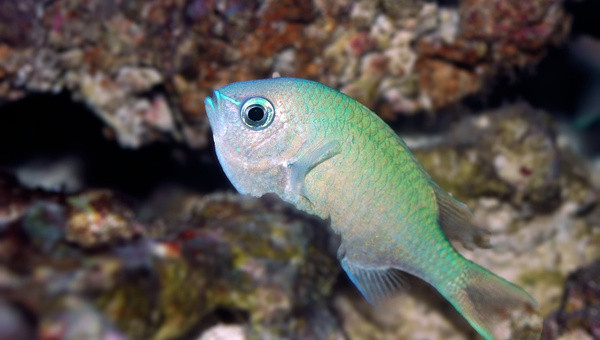
They must be kept in a shoal; at least six means they can be as comfortable as possible and shimmer as they are meant to.
Community tanks also benefit from them as they are known to eat hair algae. If you are looking for a saltwater fish that is low-maintenance and will add a splash of color to your aquarium, the Green Chromis is a perfect choice.
Green Chromis Availability
They are available all year round and are easy to find in most pet stores. The price of a Green Chromis ranges from $3 to $10.
Green Chromis Habitat
Green Chromis are found in the reefs of the Indo-Pacific. They prefer to live in schools and must be kept in a minimum shoal of six.
Check Bellus Angelfish Care: Appearance, Size, Lifespan, Diet & All
Green Chromis Breeding
The Green Chromis is a difficult fish to breed in captivity. They are known to hybridize with other members of the Chromis genus. If you are interested in breeding them, it is best to purchase a group of juveniles and allow them to grow up together.
The female will lay her eggs on the reef or in a cave, and the male will fertilize them. The fry can fend for themselves and does not require special care.
Also, check Jaguar Cichlids Care: Appearance, Lifespan
Green ChromisCare Guide
The Green Chromis is a hardy fish and can tolerate a wide range of water conditions. It is important to provide them with plenty of hiding places as they are shy fish.
Green Chromis Tankmates
Green Chromis are peaceful fish that get along well with other saltwater fish. Some good tank mates for Green Chromis include damselfish, butterflyfish, dottybacks, wrasses, and certain tangs. It is important to avoid fish, known as bullies or nippers, as they can stress out the Green Chromis and cause them harm.
Green Chromis Food & Diet
The Green Chromis is a carnivorous fish whose diet should consist of living, frozen, or flake and meaty foods.
Green Chromis Tank Requirements
The Green Chromis is a very active fish and requires a tank of at least 30 gallons. They prefer to live in reef tanks with plenty of hiding places and open swimming spaces. The water temperature should be between 72-78 degrees Fahrenheit, with a pH of 8.1-8.4 and a specific gravity of 1.020-1.025.
Green Chromis Compatibility
The Green Chromis is a peaceful fish that gets along well with other peaceful tank mates. They should not be kept with aggressive fish or fish that are much larger than them.
Green Chromis Common Possible Diseases
The Green Chromis is a hardy fish that is resistant to most diseases. However, they are susceptible to marine ich and other parasites. It is important to quarantine new fish before adding them to your tank to ensure that they are not carrying any diseases.
Tips
- The Green Chromis is a very active fish and requires a tank of at least 30 gallons.
- They are peaceful fish that get along well with other peaceful tank mates.
- The Green Chromis is a difficult fish to breed in captivity.
- The Green Chromis is a hardy fish that is resistant to most diseases. However, they are susceptible to marine ich and other parasites. It is important to quarantine new fish before adding them to your tank to ensure that they are not carrying any diseases.
Wrasses Appearance
Wrasses are a diverse group of fish that are popular in saltwater aquariums. They come in various colors and patterns, and many species are known for their interesting behaviors. With over 600 species of brilliant colors, it is no wonder they are so popular.
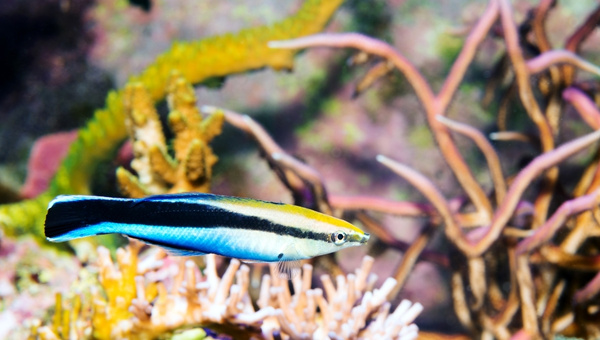
There is a lot of variation in size, but most wrasses range from 3-12 inches long.
Some common wrasse species include the cleaner wrasse (Labroides dimidiatus), sixline wrasse (Pseudocheilinus hexataenia), and the fairy wrasse (Cirrhilabrus spp.).
They are energetic fish, so they need to eat a lot to keep going and stay healthy. Feed them multiple times daily with various foods, including live, frozen, and freeze-dried foods.
Wrasse Availability
Wrasses are widely available from fish stores and online retailers. The price can range from $10 to $50, depending on the species.
Wrasse Breeding
Breeding wrasses are generally difficult and not often attempted by hobbyists. Most species are polygamous broadcast spawners, meaning the male will release his sperm into the water, and the female will scatter her eggs.
The fry is generally too small to be fed traditional foods and must be raised on tiny live foods.
Wrasse Temperament
Temperament can vary widely among wrasse species. Some are peaceful and make good tank mates for smaller fish, while others may be more aggressive and territorial. It is best to research the species you are interested in before purchasing.
Wrasse Care Guide
Most wrasses are easy to care for if they have a large enough tank and plenty of live rock for hiding and grazing. Some species may be more aggressive than others, so consider the fish's personality when choosing tank mates.
Wrasse Tank Requirements
Wrasses need a tank with plenty of live rock for hiding and grazing. They are also known to jump, so a tight-fitting lid is necessary. Water quality is important for wrasses, so make regular water changes and use a good filter system.
The pH should be 8.1-8.4, and the temperature should be 75° to 82°Fahrenheit.
Wrasse Food & Diet
Wrasses are omnivorous and need a varied diet of meaty foods and marine algae. They will often graze on live rock in the aquarium for algae. Feed them multiple times daily with various foods, including live, frozen, and freeze-dried foods.
Wrasse Tank Size
The minimum tank size for most wrasses is 30 gallons, but some larger species may need 50 gallons or more.
Also, check Black Neon Tetra 101: Best Care Guide, Species Summary & All
Wrasse Common possible Diseases
Some common diseases that can affect wrasses include marine ich (Cryptocaryon irritans), red blotch disease ( Pseudomonas flavescens), and Marine velvet disease (Amyloodinium ocellatum).
These diseases are often caused by poor water quality, so it is important to do regular water changes and use a good filter system. If you notice any signs of disease, quarantine the fish immediately and treat it with a copper-based medication.
You may also check Neon Tetra Care Guide: Appearance, Breeding & All
Tips
Here are a few tips to help you successfully keep wrasses:
- Start with a small group of wrasses and allow them to acclimate to their new environment for a few days before adding more fish.
- Wrasses are known to jump, so ensure your aquarium has a tight-fitting lid.
- Provide plenty of live rock for hiding and grazing.
- Do regular water changes and use a good filter system to maintain water quality.
- Feed them multiple times daily with various foods, including live, frozen, and freeze-dried foods.
Wrasses are a great addition to any saltwater aquarium. They are beautiful fish that come in various colors and patterns. With proper care, they can be a peaceful and active addition to your tank. Just be sure to research before purchasing and be prepared to provide them with plenty of live rock and a varied diet.
Pajama Cardinalfish Appearance
Pajama Cardinalfish is one of the most popular saltwater fish for a number of reasons. They are small, peaceful, and straightforward to care for. Cardinalfish are also very hardy, making them a great choice for beginner aquarists.
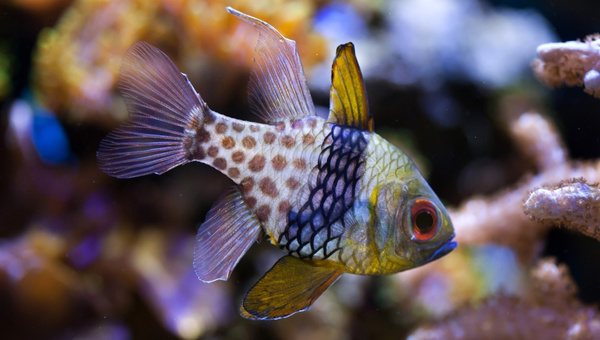
These fish are native to the reefs of the Indo-Pacific region and can be found in various colors, including red, orange, yellow, and blue.
They are diehard reef aquarium inhabitants. They do best in an established tank with plenty of live rock for hiding and grazing. A sand bed is also beneficial as it provides these fish a place to lay their eggs.
Cardinalfish are known to be shy fish, so it is important to provide them with plenty of places to hide. In the wild, Pajama Cardinalfish are found in small groups or pairs, so they should be kept in at least pairs in the aquarium.
They are omnivorous and will accept a wide variety of foods. In the aquarium, they will readily consume flake food, pellets, frozen mysis shrimp, and small live foods. It is important to provide them with a varied diet to ensure proper nutrition and health.
They are very peaceful fish that make an excellent addition to a reef aquarium. They are easy to care for and will thrive in a well-established tank with plenty of live rock and a sand bed. These fish are best kept in pairs or small groups and should be provided with a varied diet.
Pajama Cardinalfish Availability
Pajama Cardinalfish are readily available at most fish stores. The price for these fish can vary depending on the size and color. Cardinalfish are typically priced between $10 and $20.
Pajama Cardinalfish Size
Pajama Cardinalfish grow to an average size of 2-3 inches in length.
Check Cardinal Sulawesi Shrimp 101: Care Guide & Breeding Guide
Pajama Cardinalfish Lifespan
The average lifespan of Pajama Cardinalfish is 5 years.
Pajama Cardinalfish Origin
Pajama Cardinalfish are native to the reefs of the Indo-Pacific region.
Pajama Cardinalfish Family
Pajama Cardinalfish are members of the Apogonidae family.
Pajama Cardinalfish Temperament
Pajama Cardinalfish are very peaceful fish that make an excellent addition to a reef aquarium. They are best kept in pairs or small groups.
Pajama Cardinalfish Breeding
Pajama Cardinalfish are egg scatterers that form pairs during spawning. The female will lay a small batch of eggs on the substrate, where the male will then fertilize them.
Once the eggs are fertilized, the female will leave the area, and the male will assume sole responsibility for guarding and aerating the eggs. The eggs will hatch in 5-7 days, and the fry can eat small live foods. Cardinalfish are not known to crossbreed with other species.
Pajama Cardinalfish Care Guide
Pajama Cardinalfish are very easy to care for and make an excellent choice for beginner aquarists.
Pajama Cardinalfish Tankmates
Pajama Cardinalfish are compatible with most peaceful fish.
Good tank mates include:
- Dwarf Angels
- Clownfish
- Dartfish
- Dragonets
- Filefish
- Gobies
Pajama Cardinalfish Food & Diet
Pajama Cardinalfish are carnivorous and will accept a wide variety of foods. In the aquarium, they will readily consume flake food, pellets, frozen mysis shrimp, and small live foods. It is important to provide them with a varied diet to ensure proper nutrition and health.
Pajama Cardinalfish Water Conditions
Pajama Cardinalfish prefer water with the following parameters:
- Temperature: 75°-82°Fahrenheit
- pH: 8.1-8.4
- Specific Gravity:- 1.020-1.025
- Ammonia: 0 ppm
- Nitrite: 0 ppm
- Nitrate: 0-20 ppm
Pajama Cardinalfish Common Possible Diseases
Pajama Cardinalfish are very hardy fish and are not prone to disease. Some common diseases that can affect cardinalfish include Marine Ich ( Cryptocaryon irritans ), Marine Velvet ( Oodinium ocellatum ), and Red Plague ( Amyloodinium ocellatum ).
These diseases are typically the result of poor water conditions or stress. It is important to maintain good water quality and provide your fish with a stress-free environment to avoid these diseases.
Also, check Cardinal Sulawesi Shrimp 101: Care Guide & Breeding Guide
Tips
Pajama Cardinalfish are shy fish, so it is important to provide them with plenty of places to hide. In the wild, Pajama Cardinalfish are found in small groups or pairs, so they should be kept in at least pairs in the aquarium.
Damselfish Appearance
Damselfish are a diverse group of fish that are found in a wide range of colors, shapes, and sizes. They are among the most popular saltwater fish for aquariums because they are beautiful, relatively easy to care for, and very hardy.
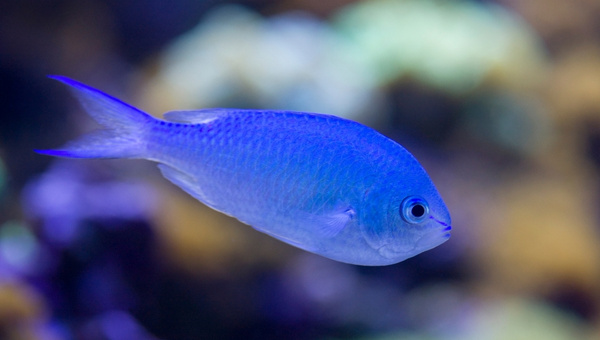
Some remain small at around three inches, while others can grow a foot long. Damselfish are found in tropical waters worldwide and come in various colors, including blue, red, orange, yellow, and green.
Most damselfish are peaceful fish, but some species can be aggressive towards tank mates. They are omnivores and will eat various foods, including Flake, pellet, live, and frozen.
They are a popular choice for saltwater aquariums because they are beautiful and relatively easy to care for. They cannot be paired with delicate or docile tank mates as they will soon outcompete them.
With over 250 species, there is plenty of variety regarding damselfish.
Some of the most popular damselfish include:
- Blue damselfish (Pomacentrus coelestis)
- Yellowtail damselfish (Chrysiptera parasema)
- Three-stripe damselfish (Dascyllus trimaculatus)
- Domino damselfish (Dascyllus albisella)
Damselfish Origin
Damselfish are found in tropical waters all over the world.
Damselfish Availability
Damselfish are widely available and relatively inexpensive. The price will depend on the specific species and where you purchase them from.
Damselfish Size & Growth
Most damselfish range in size from three to six inches, but some species can grow up to a foot long.
Damselfish Temperament
The temperament of damselfish can vary depending on the species. Some are peaceful, while others can be aggressive toward tank mates. It is best to research the specific species you are interested in before purchasing.
Check Emperor Tetra 101: Care, Breeding, Lifespan, Diet
Damselfish Breeding
Damselfish are relatively easy to breed in the home aquarium. They are egg-layers and lay their eggs on a substrate such as live rock or coral. The male damselfish will then guard the eggs until they hatch.
It is best to remove the fry to a separate tank for raising as the adult damselfish may eat them. The fry can be fed a diet of live baby brine shrimp or micro-plankton.
Also, check Cardinal Tetra 101: Species Summary & Ultimate Care Guide
Damselfish Care Guide
Damselfish are relatively easy to care for and are a good choice for beginner saltwater aquarium hobbyists. They are hardy fish that can tolerate a wide range of water conditions.
Damselfish Diet
Damselfish are omnivores who eat various foods, including Flake, pellet, live, and frozen. It is important to provide them with a varied diet for optimal health.
Damselfish Reef Safe
Most damselfish are reef safe, but some species can be aggressive toward invertebrates. It is best to research the specific species you are interested in before purchasing.
Damselfish Tank Size
The minimum tank size for most damselfish is 30 gallons, but larger tanks are preferable.
Damselfish Tank Requirement
The minimum tank size for most damselfish is 30 gallons, but larger tanks are preferable. Damselfish do best in well-established aquariums with plenty of hiding places and live rock to graze on. They prefer a sandy substrate and moderate lighting.
The water temperature should be between 72° to 79° Fahrenheit, and the pH should be 8.1-8.4. Damselfish are relatively easy to care for and are a good choice for beginner saltwater aquarium hobbyists.
Damselfish Tankmates
When choosing tankmates for damselfish, it is important to consider their temperament. Some species of damselfish can be aggressive towards other fish and invertebrates. It is best to choose tank mates that are similar in size and temperament.
Damselfish are also known to be fin nippers, so it is best to avoid pairing them with fish with long-flowing fins.
Some good tank mates for damselfish include:
- Clownfish
- Goby fish
- Cardinalfish
- Dartfish
- Blenny fish
- Wrasses
- Triggers
- Puffers
Damselfish Common Possible Diseases
Like all fish, damselfish are susceptible to a variety of diseases.
The most common diseases include:
- Ich: Ich is a parasite that causes white spots on fish skin. It is important to treat ich as soon as possible as it can be fatal. The best way to prevent ich is to maintain clean water conditions and quarantine new fish before adding them to your tank.
- Marine Velvet Disease: Marine velvet disease is caused by a parasitic dinoflagellate. It causes the skin of fish to become covered in a velvety Growth. Marine velvet disease is often fatal, and there is no cure. The best way to prevent marine velvet disease is to maintain clean water conditions and quarantine new fish before adding them to your tank.
Signs Of A Healthy Damselfish
- The following are signs that your damselfish is healthy:
- They should have a healthy appetite and should be eating regularly.
- They should have bright, vibrant coloration.
- They should be active and swimming around the tank.
- They should have clear, smooth skin with no white spots or other abnormalities.
If you notice any of the above signs, it indicates that your damselfish is not feeling well, and you should take them to a veterinarian for a check-up.
How To Care For Damselfish
The following are some tips on how to care for damselfish:
- It is important to provide damselfish with a varied diet for optimal health. Offer them a variety of foods such as Flake, pellet, live, and frozen.
- Damselfish need a well-established aquarium with plenty of hiding places and live rock to graze on.
- The water temperature should be between 72° to 79°Fahrenheit, and the pH should be 8.1-8.4.
- Damselfish are relatively easy to care for and are a good choice for beginner saltwater aquarium hobbyists.
As you can see, damselfish are a popular choice for saltwater aquariums because they are beautiful and relatively easy to care for. They come in various colors and sizes and can be found in tropical waters worldwide.
If you are thinking about adding damselfish to your saltwater aquarium, be sure to do your research to find a species that is compatible with your tank mates and has the temperament that you are looking for.
Blenny Summary
Blenny is a type of fish that is found in saltwater environments all around the world. They are known for their large eyes and slimy skin. There are over 1,000 different species of blenny, making them one of the most diverse groups of fish in the world.
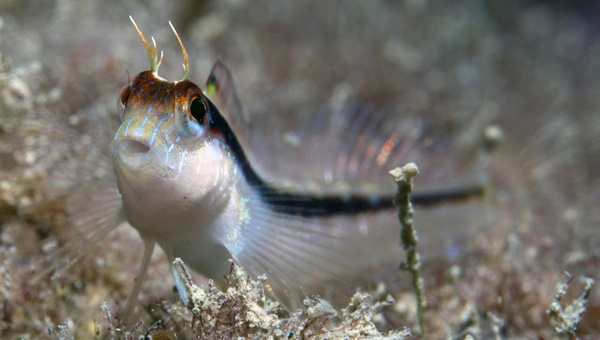
They can be territorial towards their own species and other similar-looking fish but are generally peaceful towards other animals. Blennies make good aquarium fish and are often kept as pets.
Though little, they have a big appetite for algae, making them an excellent choice for aquariums with live plants.
Blenny Availability
Blenny is widely available and can be found in pet stores, online retailers, and through specialty breeders. The price of a blenny will vary depending on the species, but they are generally affordable fish.
Blenny Size & Growth
Blennies range from 2 to 10 inches (5 to 25 cm).
Blenny Lifespan
The average lifespan of Blenny is 3 to 6 years.
Blenny Habitat
Blennies are found in saltwater environments in Fiji & Indonesia. They often inhabit reefs, lagoons, and tide pools.
Blenny Compatibility
Blennies are compatible with most peaceful aquarium fish. They can also be kept with invertebrates such as shrimp and crabs. It is best to avoid keeping them with larger, more aggressive fish.
Blenny Breeding
Blennies are not easy to breed in the home aquarium, and it is often best to leave breeding to the professionals. If you are determined to breed blennies, you need a separate breeding tank with similar water conditions to the main tank.
The female will lay her eggs on a flat surface, which the male will then fertilize. The eggs will hatch in 3-5 days, and the fry will be able to fend for themselves.
Blenny Care Guide
Blenny is relatively easy to care for and are a good choice for beginner saltwater aquarium hobbyists. They are hardy fish that can tolerate a wide range of water conditions.
Blenny Tank requirements
Blennies are relatively easy to care for and do not have high tank requirements. A 30-gallon aquarium is sufficient for most species. They prefer a sandy substrate and plenty of hiding places like rocks, live plants, or driftwood.
Blenny Tank Mates
Some good tank mates for blennies include dottyback, damselfish, clownfish, gobies, cardinalfish, and wrasses.
Check Cherry Shrimp Care Guide: Appearance, Food & Diet, Lifespan & All
Blenny Food & Diet
In the wild, blennies feed on algae and small invertebrates. In the aquarium, they will accept most sinking pellets and flakes but should also be given regular meals of live or frozen foods such as brine shrimp, mysis shrimp, and bloodworms. Blenny is omnivore fish.
Blenny Water Conditions
Blenny prefers water with the following parameters:
- Temperature: 74°-82°Fahrenheit
- pH: 8.1-8.4
- Hardness: 8 to 12 dGH
- Specific Gravity:- 1.021-1.025
Blenny Common Possible Diseases
Blennies are relatively hardy fish, but they are susceptible to the same diseases as other aquarium fish. Some common diseases that can affect blennies include ich, velvet disease, and bacterial infections.
- Ich: Ich is a parasitic infection that causes white spots to form on the fish's skin. It is highly contagious and can be fatal if left untreated.
- Velvet Disease: Velvet disease is a parasitic infection that causes a yellow or brownish film on the fish's skin. It is often fatal if left untreated.
- Bacterial Infections: Bacterial infections are common in aquarium fish and can cause symptoms such as red lesions, cloudy eyes, and lethargy. If left untreated, bacterial infections can be fatal.
Also, check Bamboo Shrimp Care Guide, Appearance, Size, Diet, & All
Prevention is the best cure for all of these diseases. Be sure to quarantine new fish before adding them to your tank and maintain a strict schedule of water changes and filter maintenance.
Tips
Here are a few tips to help you care for your blenny:
- Blennies do best in an aquarium with plenty of live plants and hiding places.
- Be sure to provide them with a varied diet including pellets and live or frozen foods.
- Blennies are territorial towards their own species and other similar-looking fish, so it is best to keep them in an aquarium with peaceful tank mates.
- Quarantine new fish before adding them to your tank to help prevent the spread of disease.
- Maintain a strict schedule of water changes and filter maintenance to keep your tank clean and healthy.
Coral Beauty Summary
Coral Beauties are one of the most popular saltwater fish for aquariums. They are peaceful, brightly colored, and easy to care for. They are a great addition to any saltwater aquarium.
They only grow to around 6 inches but will still need a big tank as they are very active fish. A minimum of 55 gallons so that they can remain active and have space to swim. Coral Beauties are reef safe and will not bother corals or other invertebrates.
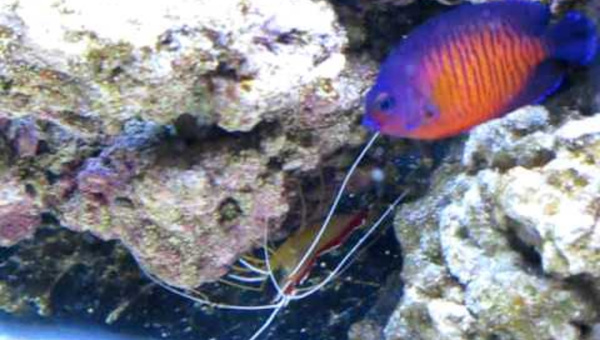
These fish will eat almost anything fed to them, especially algae and vegetable matter. They should be fed a variety of foods to keep them healthy. They may eat coral, but if properly fed, they should swim right past them.
Angelfish can be difficult to look after in community tanks, so it is best only to keep them with other peaceful fish. They are known to be bullies and chase other fish around the tank.
Coral Beauty Availability
Coral Beauties are widely available and can be found in most pet stores. The price can range from $10 to $30 depending on the size and color of the fish.
Coral Beauty Color
Coral Beauties are brightly colored and have a wide variety of color morphs. The most common colors are orange, yellow, purple, blue, and green.
Coral Beauty Size
These fish only grow to around 6 inches.
Coral Beauty Breeding
Coral Beauties are not known to breed in captivity and very little is known about their breeding habits such as their spawning trigger, egg size, or larval stage duration which is why they are not often bred in captivity.
Coral Beauty Temperament
Coral Beauties are peaceful fish that will get along well with other peaceful fish. They may chase smaller fish around the tank.
Coral Beauty Care Level
Coral Beauties are easy to care for and are a great choice for beginner saltwater aquarium owners.
Coral Beauty Minimum tank size
A minimum of 55 gallons is required for these fish.
Coral Beauty Food & Diet
Coral Beauties will eat almost anything but should be given a variety of foods to keep them healthy. They may eat coral, but if properly fed, they should swim right past them.
Check Frogspawn Coral 101: Size, Feeding, Breeding, Care Guide
Coral Beauty Reef safe
These fish are reef safe and will not bother corals or other invertebrates.
Coral Beauty Tankmates
Coral Beauties can be kept with other peaceful fish. Avoid keeping them with fish that are known to be bullies. Following these guidelines will help ensure a peaceful and harmonious aquarium.
- Damselfish
- Tomini Tang
- Gobies
- Blennies
- Wrasses
Coral Beauty Common Possible Diseases
Like all animals, saltwater fish are susceptible to diseases. The most common diseases that affect saltwater fish are white spot disease, velvet disease, ichthyophthirius multifiliis (ich), and Brooklynella hostilis.
- White Spot Disease: Also known as Cryptocaryon irritans, white spot disease is a highly contagious parasitic infection that affects saltwater fish. The parasites attach themselves to the fish and release toxins that damage the fish’s skin, fins, and gills.
- Velvet Disease: Velvet disease is caused by a protozoan parasite called Amyloodinium ocellatum. This parasite infects the fish’s gills, skin, and fins, causing the fish to develop a velvety or fuzzy appearance.
- Ichthyophthirius multifiliis (Ich): Ich is a highly contagious parasitic infection that affects saltwater fish. The parasites attach themselves to the fish and release toxins that damage the fish’s skin, fins, and gills.
- Brooklynella hostilis: Brooklynella is a freshwater bacteria that can infect saltwater fish. The infection causes the fish to develop rashes and sores on their skin. Brooklynella is most commonly spread through contaminated aquariums or live food.
Prevention is the best medicine when it comes to diseases in saltwater fish. The best way to prevent disease is to quarantine new fish for at least four weeks before adding them to your main tank.
During this time, you should monitor the fish closely for any signs of disease. It is also important to purchase your fish from a reputable dealer to ensure that they are healthy and free of disease.
If you think your fish is sick, the best course of action is to consult a veterinarian who specializes in saltwater fish. They will be able to diagnose and treat your fish properly.
Also, check Panther Grouper Care Guide: Appearance, Lifespan & Coloration & Breeding
Tips
Following are some tips to help you care for your Coral Beauty:
- Provide a minimum of 55 gallons of water.
- These fish are peaceful and should be kept with other peaceful fish. Avoid keeping them with fish that are known to be bullies.
- Feed a variety of foods to keep your fish healthy.
- Coral Beauties are reef safe and will not bother corals or other invertebrates.
- Quarantine new fish for at least four weeks before adding them to your main tank.
- Consult a veterinarian specializing in saltwater fish if you think your fish is sick.
Yellow Tang Summary
A tang is a saltwater fispecializing commonly found in the reefs of the Indo-Pacific. There are many kinds of tangs, but the most popular type among aquarium enthusiasts is the yellow tang. These brightly colored fish are relatively easy to care for and make a beautiful addition to any saltwater tank.
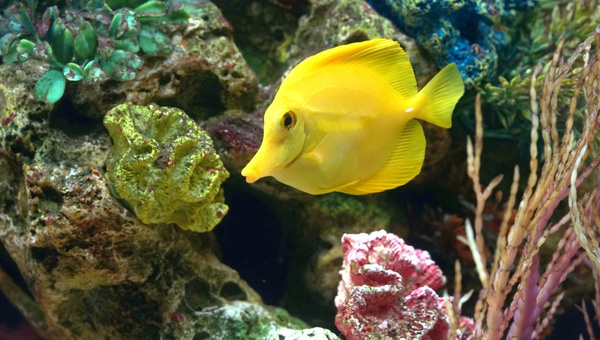
They are famous for their vibrant colors, hardiness, and relatively easy care. Yellow tangs are one of the most popular fish for beginner saltwater aquarium enthusiasts.
Most are peaceful and can be placed in community tanks, but some can be aggressive toward other fish.
They can grow to 8 inches long and should be kept in at least a 70-gallon tank. They are also known as Surgeonfish. They will eat algae that grow in the aquarium, alongside a diet of vegetables and occasionally small amounts of meat such as brine shrimp.
Yellow Tang Availability
Yellow tangs are widely available and can be found at most pet stores that sell saltwater fish. The price can range from $20 to $50, depending on the size and age of the fish.
Yellow Tang Size & Growth Rate
Yellow tangs can grow up to 8 inches in length.
Yellow Tang Lifespan
Yellow Tang can live up to 10 years in captivity with proper care and 30 years in the wild.
Yellow Tang Care Guide
Yellow tangs are relatively easy to care for, but they do require some specific care considerations. They need a large tank with plenty of live rock for grazing on algae. They should be fed a diet of marine algae, spirulina, and other vegetables. They also need much water movement and plenty of hiding places.
Yellow Tang Temperament
Most yellow tangs are peaceful fish that can get along well with other tank mates. However, some individuals can be aggressive toward other fish, so it is best to introduce them to the tank one at a time.
Check Tomini Tang Fish Care Guide: Appearance, Breeding & All
Yellow Tang Food & Diet
Yellow tangs are primarily herbivores, but they will also eat small amounts of meaty foods. Their diet should consist of marine algae, spirulina, and other vegetables. They should also be given some meaty food such as brine or mysis shrimp.
Yellow Tang Tank Requirements
Yellow tangs need a large tank with plenty of live rock for grazing on algae. They should be given a diet of marine algae, spirulina, and other vegetables. They also need much water movement and plenty of hiding places.
Yellow Tang Tankmates
Yellow tangs are generally peaceful fish that can get along well with other tank mates. However, some individuals can be aggressive toward other fish, so it is best to introduce them to the tank one at a time.
Yellow Tang Compatibility
Yellow tangs are compatible with most other saltwater fish. However, they may be aggressive towards other fish of the same species.
Yellow Tang Breeding
Yellow tangs are difficult to breed in captivity, and it is not recommended for beginner aquarists as it requires a huge tank and specialized equipment.
Yellow Tang Common Possible Diseases
Yellow tangs are susceptible to a number of diseases, including ich, marine velvet, and bacterial infections. They should be quarantined when first introduced to the tank and monitored closely for signs of illness.
Yellow Tang Disease Prevention
The best way to prevent disease in yellow tangs is to quarantine them when first introduced to the tank. They should also be kept in a tank with good water quality and plenty of live rock for grazing.
Yellow Tang Disease Treatment
If yellow tangs do become ill, they should be treated with a combination of freshwater dips and quarantining. Antibiotics may also be necessary to treat bacterial infections.
You may also check Jungle Val- Planting Procedure & Care Guide
Tips
Here are a few tips to keep in mind when caring for yellow tangs:
- Keep them in a large tank with plenty of live rock for grazing.
- Feed them a diet of marine algae, spirulina, and other vegetables.
- Provide them with plenty of water movement and hiding places.
- Be careful when adding them to a tank; they can be aggressive toward other fish.
Diamond Watchman Goby Summary
Also known as the diamond sleep goby, this fish is a beautiful and popular choice for many saltwater aquariums. This shy fish is full of character, as well as adorable looking, with vibrant orange diamonds along its body. They are relatively peaceful and get along well with other tank mates.
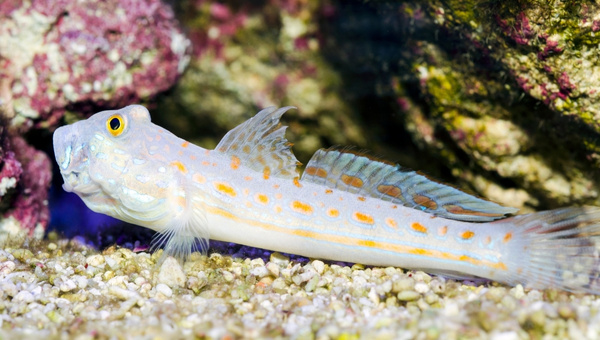
Interestingly, Diamond Watchman Goby’s can change their sex to pair up and reproduce. They will grow to around 6 inches and need a tank of at least 50 gallons.
These fish are used to feeding throughout the day in their natural habitat, so in captivity, they should be fed 2-3 times a day. They are not fussy and will accept most foods, including pellets, flakes, and live and frozen food.
The diamond watchman goby is a sand-sifting fish, which means they help to keep the substrate clean by eating uneaten food and other organic matter. They have a specialized mouth to vacuum the sand and then expel it through their gills. This process also helps to oxygenate the substrate.
When choosing a diamond watchman goby for your tank, try to select one that is already acclimated to life in captivity, as they can be quite delicate. They should also be quarantined before being introduced to your main tank.
Diamond Watchman Goby Availability
These fish are widely available from most good aquarium stores. The price can vary depending on the size and coloration of the fish. Following quarantine, they should be easy to acclimate to your main tank.
Diamond Watchman Goby Breeding
These fish can change their sex to pair up and reproduce. They will lay their eggs on a hard surface such as a rock. The male will then guard the eggs until they hatch. When the fry is born, they should be fed live foods such as baby brine shrimp.
Diamond Watchman Goby Temperament
These fish are peaceful and make good community tank mates. They have been known to get along with most other fish species. However, they can be shy, so they provide plenty of hiding places.
Diamond Watchman Goby Care
The care level for these fish is a beginner to intermediate. They are pretty delicate when first introduced to captivity but once settled; they are hardy and adaptable.
Diamond Watchman Goby Tankmate
The following fish are suitable tank mates for the diamond watchman goby:
- Other peaceful saltwater fish
- Other sand-sifting fish
- Some algae eaters
- Coral
- Some invertebrates
Do not keep with aggressive or predatory fish, as they will stress the diamond watchman goby. Avoid keeping with larger fish as they may eat them.
Diamond Watchman Goby Food & Diet
The diet of the Diamond Watchman Goby should consist of a variety of live, frozen, and dry foods. They are not fussy eaters but should be given 2-3 small meals per day.
Diamond Watchman Goby Tank Requirements
A minimum tank size of 50 gallons is required for these fish. They prefer a sandy substrate with plenty of hiding places. The pH level should be between 8.1 to 8.4, and the water temperature should be 72° to 78°Fahrenheit.
Diamond Watchman Goby Common Possible diseases
The following diseases have been known to affect the diamond watchman goby:
- Ich: This is a common parasitic disease that can be fatal if left untreated. Symptoms include white spots on the body and flashing. Ich can be treated with a number of different medications, such as copper sulfate or quinine hydrochloride.
- Marine Velvet Disease: This is a parasitic disease caused by a waterborne protozoan. Symptoms include flashing, loss of appetite, and lethargy. The fish will also have a velvety appearance to their skin. Marine velvet disease can be treated with a number of different medications, such as copper sulfate or quinine hydrochloride.
- Gill Flukes: This is a parasitic disease that affects fish's gills. Symptoms include heavy breathing, lethargy, and loss of appetite. Gill flukes can be treated with a number of different medications, such as copper sulfate or quinine hydrochloride.
Check Ultimate Dragon Goby 101: Care, Appearance, Food, Habitat & All
Tips
Following are some tips to help you care for your diamond watchman goby:
- Quarantine new fish before adding them to your main tank.
- Provide plenty of hiding places.
- Perform regular water changes.
- Feed a variety of live, frozen, and dry foods.
- Monitor the water quality closely.
- Treat any diseases promptly.
These fishes are one of the most popular choices for saltwater aquariums. They are attractive, peaceful, and relatively easy to care for. However, they are pretty delicate when first introduced to captivity, so ensure you are prepared to provide the necessary care.
Copperband Butterflyfish Appearance
Butterflyfish are a beautiful addition to any saltwater aquarium. They are relatively easy to care for and will add color to your tank. Butterflyfish come in various colors and patterns, so you’ll indeed find one that fits your taste.
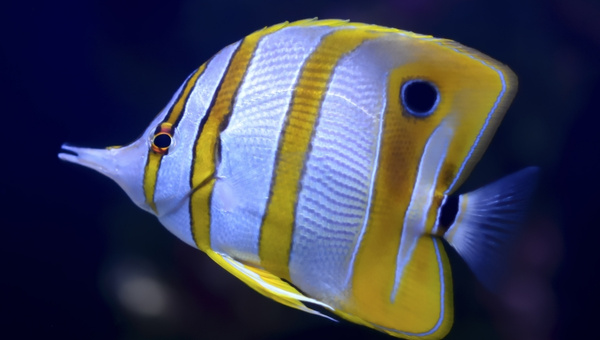
They are one of the most beautiful saltwater fish and popular for aquariums. However, they can be difficult to keep alive, as they are sensitive to changes in water quality. If you’re looking for a challenge, and are up for caring for a delicate fish, then a butterflyfish may be the right choice for you.
Some are suitable for reef tanks, such as the Copperband Butterflyfish, while others will nip at coral. It’s important to do your research before adding a butterflyfish to your tank to make sure it is compatible with the other fish and invertebrates you have.
This fish needs a large aquarium of at least 75 gallons and should only be kept with other peaceful fish. Butterflyfish are not recommended for beginner aquarium hobbyists.
Most must eat a varied diet, including brine shrimp, mysis shrimp, chopped squid, and freeze-dried krill.
Copperband Butterflyfish Availability
Butterflyfish are widely available and can be found at most pet stores. A butterflyfish can range from $20 to $100, depending on the species.
Copperband Butterflyfish Size & Growth
Butterflyfish range in size from 4 to 8 inches.
Copperband Butterflyfish Lifespan
In captivity, the average lifespan of a Copperband Butterflyfish is between 6-10 years, with the proper care. But they can live up to 12 years in the wild.
Check Bumblebee Goby Best Care Guide: Size, Tank, Food & All
Copperband Butterflyfish Breeding
Butterflyfish are difficult to breed in captivity, and it is not recommended for beginner aquarium hobbyists.
Copperband Butterflyfish Care Guide
Copperband Butterflyfish are delicate fish that can be difficult to care for. They are picky and require a diet of live foods, such as brine shrimp, Mysis shrimp, and copepods. They will quickly starve to death if they do not receive enough food.
Copperband Butterflyfish Food & Diet
Butterflyfish are carnivores and will eat a variety of meaty foods. They should be fed a diet that includes: brine shrimp, mysis shrimp, chopped squid, and freeze-dried krill.
Copperband Butterflyfish Tank Requirements
Butterflyfish need a large aquarium of at least 75 gallons and should only be kept with other peaceful fish. The tank should have plenty of hiding places, as well as live rock for the fish to graze on.
Copperband Butterflyfish Water Conditions
Butterflyfish are sensitive to changes in water quality and need to have stable conditions. The water should be good quality, with a temperature between 75° to 84°Fahrenheit. The pH should be between 8.1 and 8.4, and the specific gravity should be between 1.020 and 1.025.
Copperband Butterflyfish Compatibility
Butterflyfish are compatible with most peaceful fish but should not be kept with aggressive fish or invertebrates.
Copperband Butterflyfish Tank Mates
Some suitable tank mates for butterflyfish include wrasses, dottybacks, clownfish, and angelfish.
Copperband Butterflyfish Common Possible Diseases
Butterflyfish are susceptible to a number of diseases, including ich, marine velvet, and flukes. They are also sensitive to changes in water quality, so it’s important to keep a close eye on their tank conditions.
If you notice any changes in your butterflyfish’s behavior or appearance, consult a veterinarian specializing in saltwater fish.
Following a proper quarantine protocol is the best way to avoid introducing disease into your tank. Any new fish or invertebrates should be quarantined for at least 4 weeks before being introduced to your main tank.
Also, check 9 Best Types of Freshwater Aquarium Catfish
Tips
Here are some tips for keeping your butterflyfish healthy and happy:
- Keep the water quality in their tank stable.
- Feed them a varied diet that includes meaty foods.
- Provide plenty of hiding places in their tank.
- Monitor them closely for signs of illness.
- Consult a veterinarian if you notice any changes in their health.
Some butterflyfish are suitable for reef tanks, while others may nip at coral. It’s important to do your research before adding a butterflyfish to your tank to make sure it is compatible with the other fish and invertebrates you have.
Orange Spotted Goby
These Gobies make good community fish and get along with other peaceful species. They have an orange body with black spots and reach a maximum size of about 3.5 inches. A magnificently patterned goby, the orange-spotted goby is a curious fish.
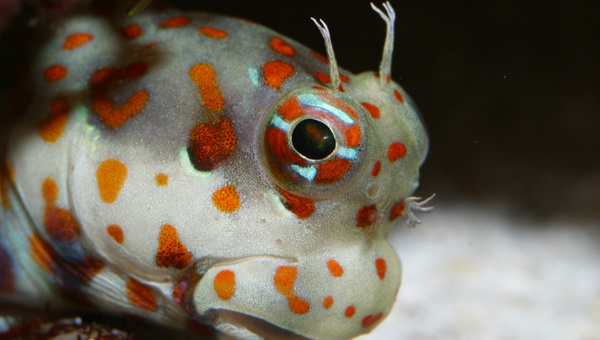
Goby fish love to hide but also need their hiding place to have an opening so they can keep an eye on what's going on. If their home is too tight, they will wedge themselves in and die. Be sure to give them plenty of nooks and crannies to swim into and explore.
This fish needs feeding a minimum of twice a day. The orange spotted goby is a voracious eater and will accept most meaty foods. They particularly like live foods such as brine shrimp, mysis shrimp, and bloodworms.
They are also known to nip at the fins of other fish, so they may not be the best tankmate for slow-moving or long-finned fish. They are jumpers, so a tightly fitted lid is a must. They are known to be escape artists, so a secure lid is key.
Orange Spotted Goby Availability
Orange Spotted Gobies are widely available and relatively inexpensive. A single fish can range from $5 to $20.
Orange Spotted Goby Tank Size
These gobies do best in a tank that is at least 10 gallons and has plenty of hiding places. Live rock with lots of nooks and crannies is ideal.
Orange Spotted Goby Tank requirements
Following are some tank requirements for orange-spotted gobies:
- pH range: 8.1-8.4
- ammonia: 0ppm
- nitrite: 0ppm
- nitrate: <20ppm
- sg: 1.020-1.025
- Temp: 72° to 78° F
Orange Spotted Goby Compatibility
Orange Spotted Gobies are compatible with most peaceful fish. They may nip at the fins of long-finned or slow-moving fish, so tankmates should be chosen accordingly.
Orange Spotted Goby Tankmates
Orange Spotted Gobies can be kept with other peaceful fish that are small to medium in size. They may nip at the fins of slow-moving or long-finned fish, so they are not the best tankmates for those species. Some possible tankmates include:
- Clownfish
- Dartfish
- Firefish
- Cardinalfish
- Jawfish
Orange Spotted Goby Care Guide
Orange Spotted Gobies are relatively easy to care for if their basic needs are met. They are hardy and can tolerate a wide range of water parameters but prefer neutral to slightly alkaline water with a temperature between 72° to 78° Fahrenheit.
They are relatively easy to care for as long as their basic needs are met. They are hardy and can tolerate a wide range of water parameters but prefer neutral to slightly alkaline water with a temperature between 72° to 78° Fahrenheit.
Orange Spotted Goby Food & Diet
Orange Spotted Gobies are voracious eaters and will accept most meaty foods. They particularly like live foods such as brine shrimp, mysis shrimp, and bloodworms. A varied diet of both live and frozen foods is ideal. They should be fed 2-3 times per day.
Orange Spotted Goby Breeding
Orange spotted gobies are relatively easy to breed in the home aquarium. They are substrate spawners and will lay their eggs on the bottom of the tank.
Once the eggs are laid, the parents will usually eat them, so it is best to remove them to a separate breeding tank. The fry can be fed live baby brine shrimp or micro worms.
Also, check Ghost Shrimp 101: Best Detailed Care Guide
Orange Spotted Goby Common Possible Diseases
Orange spotted gobies are relatively hardy and do not often fall prey to disease. However, like all fish, they are susceptible to stress-related illnesses if their environment is not ideal. Some common diseases that can affect orange spotted gobies include:
- Orange Spotted Goby Ammonia Poisoning: Ammonia poisoning is one of the most common and deadly diseases that can affect orange spotted gobies. Ammonia is a toxic gas that is produced by the decomposition of fish waste and uneaten food. It is highly corrosive and can burn the skin, gills, and eyes of fish.
Symptoms of ammonia poisoning include:
- Rapid breathing
- Flashing
- Clamped fins
- Loss of appetite
- lethargy
If you notice any of these symptoms, it is important to test the ammonia levels in your tank immediately. If ammonia is present, it must be removed from the water using a chemical filter media such as activated carbon.
- Nitrite Poisoning: Nitrite poisoning is another common and deadly disease that can affect orange spotted gobies. Nitrite is produced by the decomposition of ammonia and is just as toxic to fish as ammonia.
Symptoms of nitrite poisoning include:
- Difficulty breathing
- Flashing
- Clamped fins
- Loss of appetite
- Lethargy
If you notice any of these symptoms, it is important to immediately test the nitrite levels in your tank. If nitrite is present, it must be removed from the water using a chemical filter media such as activated carbon.
- Velvet Disease: Velvet disease is a parasitic infection that can affect orange spotted gobies. It is caused by a single-celled organism called Oodinium pilularis.
Symptoms of velvet disease include:
- Flashing
- Clamped fins
- Loss of appetite
- Lethargy
If you notice any of these symptoms, it is important to immediately quarantine the affected fish in a hospital tank. Velvet disease is highly contagious and can quickly spread throughout an entire aquarium.
It can be treated with a copper-based medication, but it is important to follow the instructions carefully to avoid harming the fish.
- Hole in the Head Disease: Hole in the head disease is a parasitic infection that can affect orange spotted gobies. It is caused by a single-celled organism called Hexamita discus.
Symptoms of hole-in-the-head disease include:
- Flashing
- Clamped fins
- Loss of appetite
- Lethargy
If you notice any of these symptoms, it is important to immediately quarantine the affected fish in a hospital tank.
Hole-in-the-head disease is highly contagious and can quickly spread throughout an entire aquarium. It can be treated with a metronidazole-based medication, but it is important to follow the instructions carefully to avoid harming the fish.
Orange Spotted Goby Preventing Disease
The best way to prevent disease is to maintain a clean and healthy environment for your orange spotted goby. Some tips for preventing disease include:
- Regular water changes: Be sure to perform regular water changes to remove toxins and waste from the aquarium.
- Quarantine new fish: Always quarantine new fish before adding them to your tank. This will help to prevent the spread of disease.
- Keep an eye on your fish: Pay close attention to your fish and look for any signs of illness. If you notice anything unusual, be sure to contact your veterinarian right away.
Orange spotted gobies are beautiful and peaceful fish that makes a great addition to any aquarium. However, they are susceptible to a variety of diseases. It is important to be aware of these diseases and take steps to prevent them.
By following the tips above, you can help to keep your orange spotted goby healthy and happy for many years to come.
Firefish Summary
The firefish is a popular choice for saltwater aquariums because of its vibrant colors and interesting patterns. The fish gets its name from the bright red stripe that runs along its body.
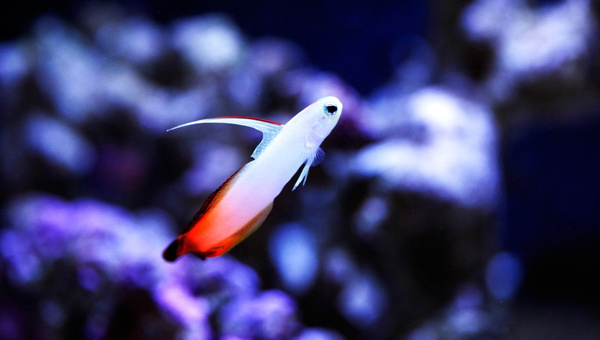
It is the perfect reef fish as it acts as natural pest control, eating small invertebrates. They show unique behaviors that are reserved for when they are at ease.
They also have a personality of their own and some have been known to learn tricks. Which includes frantic roaming and quiet observation of the tank. Open spaces and a hiding hole will allow them to do both.
This fish is an omnivore and will need feeding twice a day. Food should include flakes, pellets, and live/frozen foods.
Availability
Firefish are readily available from most pet stores. The price will depend on the size of the fish and the store you purchase it from.
Firefish Size
These fish grow to an average size of 2-3 inches.
Firefish Lifespan
The lifespan of a firefish is around 5 years.
Firefish Breeding
Breeding firefish is not difficult, but it is hard to tell the difference between male and female fish. The best way to breed them is to put a group of 6 or more fish in a tank and let them pair off.
The female will lay eggs on the substrate, which the male will then fertilize. After about 10 days, the fry will hatch and should be fed small live foods.
Firefish Care Guide
The care level for a firefish is easy. These fish are hearty and very disease resistant. They are also easy to feed and adapt well to most aquarium conditions.
Firefish Minimum Tank Size
The tank size for a firefish should be at least 10 gallons.
Check Firemouth Cichlid 101: Diet, Size, Care Guide & All
Firefish Tank Conditions
- Temperature: 72° to 78°Fahrenheit
- Specific Gravity: 1.020-1.025
- pH: 8.1-8.4
- dKH: 8-12
Firefish Compatibility
The firefish is a peaceful community fish that gets along well with other tank mates. They are known to be shy, so it is best to keep them in groups of 3 or more. They are compatible with most fish that have similar care requirements.
Firefish Diet
The diet of the firefish should consist of flake food, pellets, and live/frozen foods. Feeding them 2-3 times a day is sufficient.
Firefish Tankmates
Some good tank mates for the firefish include blue chromis, damselfish, clownfish, dottybacks, and cardinalfish.
Firefish Common Possible Diseases
The firefish is a very disease-resistant fish, but there are a few diseases that they are susceptible to. Following are some of the most common diseases that can affect the firefish:
- Marine Ich: This is a very common disease in saltwater fish. It is caused by a parasite that attacks the fish's skin. The fish will develop white spots on their body, which can eventually lead to death.
- Hole in the Head Disease: This disease is caused by a parasite that burrows into the fish's head. The fish will develop small holes in their head, which can eventually lead to death.
- Marine Velvet Disease: This disease is caused by a parasitic fungus that attacks the fish's skin. The fish will develop velvet-like patches on their body, which can eventually lead to death.
Also, check Ghost Shrimp 101: Best Detailed Care Guide
Tips
The firefish is a very disease-resistant fish, but there are a few diseases that they are susceptible to. Following are some tips on how to keep your firefish healthy:
- Keep the tank clean and the water quality high.
- Perform regular water changes and add an aquarium filter.
- Quarantine new fish before adding them to the main tank.
- Avoid overfeeding and provide a varied diet.
- Keep the tank temperature between 72-78 degrees Fahrenheit.
- Keep the specific gravity between 1.020-1.025.
- Keep the pH between 8.1-8.4.
- Keep the dKH between 8-12.
- Keep the tank well-lit.
- Provide plenty of hiding places for the fish.
- Keep the tank size at least 10 gallons.
- Keep the fish in groups of 3 or more.
- Avoid keeping them with fish that have aggressive tendencies.
- Do not overcrowd the tank.
- Do not keep them with fish that have different care requirements.
- Do not breed them in tanks that are too small.
- Use live foods when breeding them.
- Do not overfeed the fry.
- Remove sick or dead fish from the tank immediately.
- Do not put too much stress on the fish.
- Do not handle them too much.
Dottyback Summary
Dottyback is one of the most popular saltwater fish. It is a small, brightly colored fish that is found in reefs throughout the world. Dottyback is known for its behavior and bold colors.
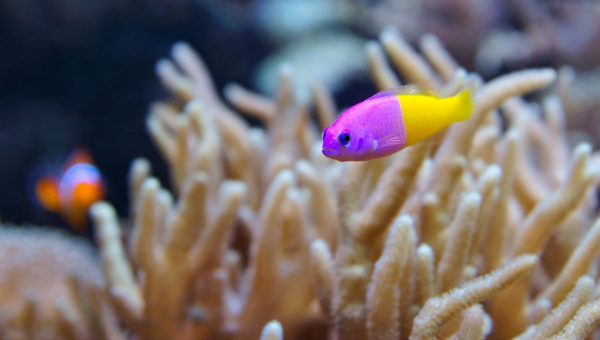
They are best described as introverts that will sometimes brave the open waters. They are remarkably hardy and can often be the first fish to return to a reef after a storm.
Dottyback are carnivores and their diet consists mainly of small crustaceans and fish. This makes them a great choice for beginners, provided their temperament is kept in check.
Many species are peaceful, but some can be quite aggressive, especially towards smaller fish.
One of the most popular species of Dottyback includes the Purple Dottyback (Pseudochetus Spp.), which is a beautiful fish with purple and white stripes.
Dottyback Availability
Dottyback is widely available in the aquarium trade. The price will vary depending on the size and species.
Dottyback Size & Growth Rate
Dottyback ranges in size from 2-4 inches (5-10 cm).
Dottyback Lifespan
Dottyback has a lifespan of 5-7 years.
Dottyback Habitat
Dottyback is found in reefs throughout the world.
Dottyback Temperament
Some species of Dottyback can be aggressive, while others are peaceful.
Check Paradise Fish Care Guide, Appearance, Food, Size & All
Dottyback Breeding
When we talk about the breeding of Dottyback, it is not an easy task for beginners. It can be done by experienced aquarists only. The female Dottyback will lay hundreds of eggs on the rocks or in the coral. The male Dottyback will then fertilize them.
After that, the fry will hatch in about a week. The fry will be very small and you will need to feed them live foods.
Dottyback Care Level
Dottyback is easy to care for as long as their diet is met and they have a tank with plenty of hiding places.
Dottyback Tank Size
Dottyback should be kept in a tank that is at least 10 gallons.
Dottyback Water Parameters
The following water parameters should be met for Dottyback:
- pH: 8.1 to 8.4
- Temperature: 72-78 degrees Fahrenheit
- Specific Gravity: 1.020-1.025
- Hardness: 8-12 dKH
Dottyback Compatibility
Dottyback is compatible with most other fish, but should not be kept with smaller fish as they may become aggressive.
Dottyback Tank Mates
Some good tank mates for Dottyback include flame angelfish,clownfish, damselfish, and wrasses.
Dottyback Food & Diet
The diet of a Dottyback should consist of small crustaceans, mysis shrimp, and vitamin-enriched frozen foods.
Dottyback Common Possible Diseases
The most common diseases that Dottyback suffers from are Marine Velvet, Cryptocaryon, and Brooklynella. If you notice any of these symptoms, it is important to seek medical attention for your fish as soon as possible. Prevention is the key to a healthy marine aquarium.
- Symptoms: The symptoms of these diseases include lethargy, loss of appetite, and white spots on the body.
- Treatment: The treatment for these diseases includes quarantining the fish, changing the water conditions, and using medications.
- Prevention: The best way to prevent these diseases is to quarantine new fish before adding them to your tank. You should also regularly test your water quality and make sure that your tank is clean.
Also, check Frogspawn Coral 101: Size, Feeding, Breeding, Care Guide
Tips
Here are some tips that will help you to take care of your Dottyback:
- Provide plenty of hiding places in the tank for your Dottyback. This will help reduce their stress levels and make them feel more comfortable.
- Do not overfeed your Dottyback. They should be fed 2-3 times per week.
- Dottyback are carnivores and their diet should consist of small crustaceans and vitamin-enriched frozen foods.
- Quarantine new fish before adding them to your tank. This will help prevent the spread of diseases.
- Regularly test your water quality and make sure that your tank is clean.
- Dottyback is not easy to breed, so it is best to leave this to experienced aquarists.
Dottyback are typically compatible with most other fish, but should not be kept with smaller fish as they may become aggressive.
Mollie Summary
Mollies (Poecilia sphenops) are one of the most popular fish for beginners due to their peaceful nature and easy care. They come in a variety of colors and can grow to be about 5.5 inches long. Mollies prefer to live in schools, so it’s best to keep them in pairs or groups.
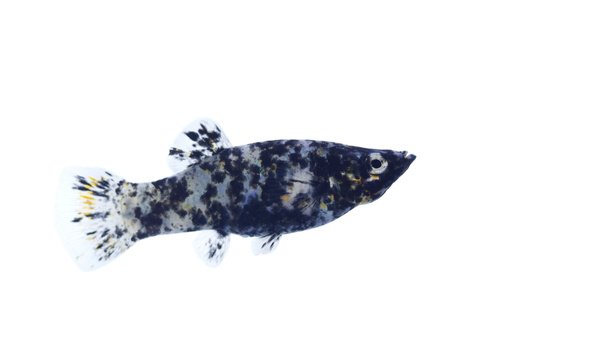
They are peaceful and make excellent community fish though they prefer a planted aquarium with lots of hiding places. They are very social and will enjoy spending time with the other fish in a community tank.
They are omnivores and will eat just about anything, but you should supplement their diet with algae wafers or pellets.
Most will grow to around 4 inches, making them a great choice for smaller aquariums. Mollies are livebearers, which means they give birth to live young. They can have up to fry (baby fish) at a time and will give birth every 4-6 weeks.
They are most popular as freshwater fish but can adapt to saltwater conditions if need be.
Mollie Appearance
Mollies come in a variety of colors, including black, silver, gold, and copper. They have a round body shape and long fins.
Mollie Availability
Mollies are widely available and easy to find. You can find them at most pet stores. The price will vary depending on the color and variety of Molly you choose.
Mollie Size & Growth Rate
Mollies grow to be about four inches long. Most will grow to around 4 inches.
Mollie Lifespan
The average life span for a Molly is 5-7 years.
Mollie Origin
Mollies are native to the Atlantic coast of North and South America. They have also been introduced to other parts of the world, including Asia and Africa.
Check Rosy Barb 101: Care, Species, Appearance, Tankmates, Habitat & All
Mollie Temperament
Mollies are generally peaceful fish. They do well in community tanks and get along with most other fish.
Mollie Breeding
Mollies are livebearers and will give birth to live young. They can have up to fry (baby fish) at a time and will give birth every 4-6 weeks.
Mollie Care Guide
Mollies are considered to be easy to care for. They are a good choice for beginner fish keepers.
Mollie Food & Diet
Mollies are omnivores and will eat just about anything. You should supplement their diet with algae wafers or pellets.
MollieTank Size
Mollies need at least a 20-gallon tank. They prefer a planted aquarium with lots of hiding places.
Mollie Tank Conditions
Mollies prefer to live in warm water. The ideal temperature range is 70° to 79° Fahrenheit. They also like to have a lot of vegetation in their tank.
Mollie Compatibility
Mollies do well in community tanks. They are peaceful fish that get along with most other fish.
Mollie Tank Mates
Some good tank mates for mollies include guppies, platies, swordtails, tetras, and rainbows.
Mollie Common Possible Diseases
Some common diseases that mollies may get include white spot disease, fin rot, and ich.
- Prevention: The best way to prevent diseases in mollies is to quarantine new fish before adding them to your tank. You should also regularly clean your tank and keep the water conditions stable.
- Symptoms: Some common symptoms of diseases in mollies include white spots on the body, frayed fins, and increased respiratory rate.
- Treatment: If your molly becomes sick, you should take it to a vet for treatment. Some common treatments include antibiotics, copper sulfate, and formalin.
Also, check Jaguar Cichlids Care: Appearance, Lifespan
Tips
Here are some tips for keeping mollies:
- Mollies need at least a 20-gallon tank.
- Mollies prefer to live in warm water. The ideal temperature range is 70° to 79° Fahrenheit.
- Mollies also like to have a lot of vegetation in their tank.
- Mollies are omnivores and will eat just about anything. You should supplement their diet with algae wafers or pellets.
- Mollies are livebearers and will give birth to live young. They can have up to fry (baby fish) at a time and will give birth every 4-6 weeks.
- Some common diseases that mollies may get include white spot disease, fin rot, and ich.
- The best way to prevent diseases in mollies is to quarantine new fish before adding them to your tank. You should also regularly clean your tank and keep the water conditions stable.
Royal Gramma Summary
Royal Gramma (Gramma loreto), also known as the fairy basslets, is a species of small saltwater fish in the Grammatidae family. The royal gramma is one of the most popular saltwater aquarium fish due to its vibrant purple and yellow colors. It is found in reefs throughout the Caribbean Sea and the Western Atlantic Ocean.
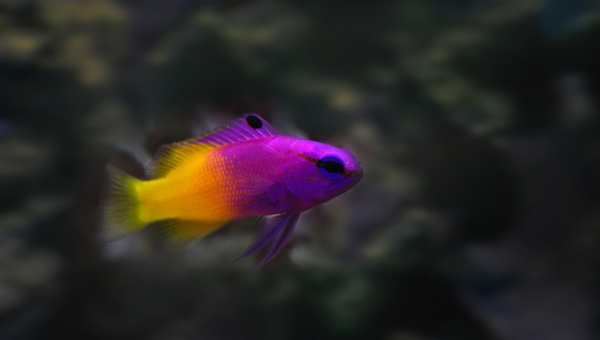
They are easy to pair with other saltwater fish, in tanks as small as 30 gallons. The tank must have enough hiding places and dim lighting for them to feel secure.
It has a rich purple body with yellow fins and a black stripe that runs from the snout, through the eye, to the base of the tail. The royal gramma is a peaceful fish that can be an excellent addition to any saltwater aquarium.
This color will stay vibrant if they are able to eat a variety of foods including meaty foods, vegetables, and marine algae.
Royal Gramma Availability
Royal Gramma is widely available in the aquarium trade. The price for a Royal Gramma can range from $5 to $20.
Royal Gramma Size
The average size of a Royal Gramma is 3-4 inches.
Royal Gramma Lifespan
The lifespan of a Royal Gramma is 5-6 years or more.
Royal Gramma Temperament
The temperament of a Royal Gramma is peaceful. They are a good addition to most saltwater aquariums.
Royal Gramma Breeding
When we talk about breeding saltwater fish, it is important to remember that most species are not easy to breed in captivity. The Royal Gramma is one of the few that can be successfully bred in an aquarium.
To breed Royal Gramma, you will need to have a tank that is at least 50 gallons in size. The tank should be set up with plenty of hiding places and dim lighting. The water quality should be excellent and the temperature should be between 78° to 80°Fahrenheit.
The male and female Royal Gramma will form a bond and the female will lay eggs on the rockwork or coral in the tank. Once the eggs are laid, the male will fertilize them. It is important to remove the parents from the tank after spawning because they may eat the eggs.
The eggs will hatch in 3-5 days and the fry will be free swimming a week after that. The fry should be fed small live foods such as copepods or rotifers. Once they are large enough, they can be fed baby brine shrimp or mysis shrimp.
Royal Gramma Care Guide
The care level for a Royal Gramma is easy. They are peaceful fish that does well in most aquariums.
Royal Gramma Food & Diet
The diet of a Royal Gramma should include meaty foods, vegetables, and marine algae.
Royal Gramma Coloration
The coloring of a Royal Gramma is purple with yellow fins and a black stripe running from the snout to the base of the tail.
Royal Gramma Compatibility
Royal Gramma is compatible with most saltwater fish. They should be added to an aquarium with other peaceful fish.
Royal Gramma Habitat
Royal Gramma is found in reefs throughout the Caribbean Sea and Western Atlantic Ocean.
Royal Gramma Tank Size
A minimum tank size of 30 gallons is recommended for Royal Gramma.
Royal Gramma Water Requirements
Royal Gramma prefers saltwater that is of good quality and has a temperature range of 72° to 78°Fahrenheit. The specific gravity should be between 1.020 to 1.025 and the pH should be between 8.1 to 8.4.
Royal Gramma Common Possible Diseases
Royal Gramma is generally healthy fish but there are a few diseases that they are susceptible to. These diseases include marine velvet, ich, and flukes.
- Marine Velvet: Marine velvet is a parasitic disease that can affect Royal Gramma. The parasites attach themselves to the fish and cause them to itch and scratch. This can lead to secondary bacterial infections and eventually death.
- Ich: Ich is a parasitic disease that is caused by a single-celled organism. The parasites attach themselves to the fish and cause them to itch and scratch. This can lead to secondary bacterial infections and eventually death.
- Flukes: Flukes are parasitic flatworms that can infest Royal Gramma. The parasites attach themselves to the fish and cause them to itch and scratch. This can lead to secondary bacterial infections and eventually death.
Royal Gramma Prevention and Treatment
The best way to prevent diseases in Royal Gramma is to maintain good water quality and quarantine new fish before adding them to the tank.
If your fish do become infected with a disease, it is important to treat them as quickly as possible. Marine velvet, ich, and flukes can all be treated with copper-based medications.
Tips
Here are a few tips to help you keep your Royal Gramma healthy and happy:
- Maintain good water quality.
- Quarantine new fish before adding them to the tank.
- Treat diseases quickly.
- Provide plenty of hiding places.
- Keep the lights dim.
Royal Gramma is a good choice for a beginner saltwater aquarium. They are peaceful and relatively easy to care for and breed. They do not need a lot of care. They are relatively easy to care for and breed.
The best way to keep them healthy is to maintain good water quality and quarantine new fish before adding them to the tank. They do not need a lot of space.
Flame Hawkfish
Flame Hawkfish (Neocirrhites armatus) is one of the most popular saltwater fish. They are known for their vibrant colors and interesting patterns. These fish are found in a variety of habitats, but they are most commonly found in coral reefs.
They are carnivores and their diet consists mainly of small crustaceans and other invertebrates. These fish are relatively peaceful, but they can be aggressive toward other fish that invade their territory.
It will perch on the top of the coral and swoop down to capture its prey. They are popular fish among saltwater aquarium hobbyists. These fish are relatively easy to care for, but they do require a well-established aquarium with plenty of hiding places.
Hawkfish are not the best swimmers, so care should be taken when keeping them with larger more aggressive fish. They are also difficult to feed, as dried and frozen food does not quite cut it for them. Persistence will lead to positive results though.
Flame Hawkfish Appearance
As the name suggests, Flame Hawkfish are characterized by their vibrant colors. Their bodies are typically orange or red, with white spots or bars.
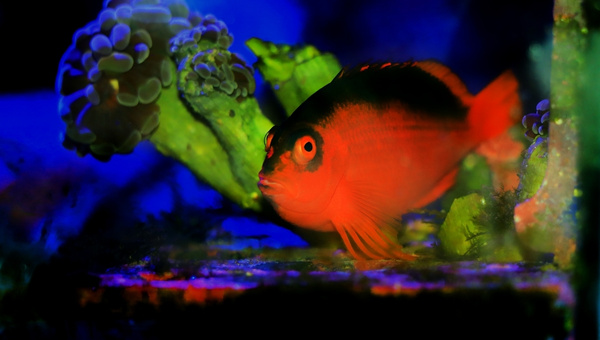
Some specimens may also have yellow or green coloration.
Flame Hawkfish Availability
Flame Hawkfish are widely available and relatively inexpensive. The price of these fish can range from $20 to $40.
Flame Hawkfish Size & Growth Rate
These fish grow to a maximum size of five inches.
Flame Hawkfish Lifespan
The average lifespan of a Flame Hawkfish is 10 years, but some specimens have been known to live for up to 15 years.
Flame Hawkfish Origin
These fish are found in the Indo-Pacific region, from the Red Sea to Hawaii.
Flame Hawkfish Care Guide
Flame Hawkfish are relatively easy to care for, but they do require a well-established aquarium with plenty of hiding places. Hawkfish are not the best swimmers, so care should be taken when keeping them with larger more aggressive fish.
Flame Hawkfish Tank Size
A minimum tank size of 30 gallons is recommended for Flame Hawkfish.
Flame Hawkfish Water Requirements
These fish are found in a variety of habitats, but they seem to do best in saltwater that has a pH between 8.1 and 8.4. The water should also be rich in calcium and magnesium.
Flame Hawkfish Compatibility
Flame Hawkfish is compatible with most other saltwater fish, but they can be aggressive towards fish that invade their territory. They are also not the best swimmers, so care should be taken when keeping them with larger more active fish.
They are also known to be nippy, so care should be taken when keeping them with smaller fish.
Flame Hawkfish Tankmates
Good tank mates for Flame Hawkfish include Angelfish, Butterflyfish, Cardinalfish, Clownfish, Dwarf Angelfish, Dwarf Gobies, Firefish, and Royal Gramma Basslets.
Flame Hawkfish Food & Diet
Flame Hawkfish are carnivores and their diet consists mainly of small crustaceans and other invertebrates. These fish are relatively easy to feed, but they do require a well-established aquarium with plenty of hiding places.
Flame Hawkfish Breeding
Flame Hawkfish are not easy to breed in captivity. These fish are oviparous, meaning that they lay eggs. The female will lay her eggs on a hard surface, such as a rock or piece of coral.
The male will then fertilize the eggs. The fry will hatch after about two weeks and they will be able to feed on small crustaceans and other invertebrates.
Flame Hawkfish Common Possible Diseases
Some common diseases that can affect Flame Hawkfish include Cryptocaryon irritans (marine white spot disease) and Amyloodinium ocellatum ( marine velvet disease). These diseases are relatively easy to treat, but they can be deadly if left untreated.
- Prevention: The best way to prevent these diseases is to quarantine new fish and provide them with the proper care.
Tips
Here are a few tips to help you keep your Flame Hawkfish healthy and happy:
- Provide plenty of hiding places for your fish.
- Do not keep these fish with larger more aggressive fish.
- Be persistent when feeding these fish, as they can be difficult to feed.
- Keep the water in your aquarium clean and well-maintained.
- Quarantine new fish before adding them to your aquarium.
With proper care, Flame Hawkfish can make a great addition to any saltwater aquarium. These fish are relatively easy to care for and they are very interesting to watch. If you are looking for a colorful and active fish, then the Flame Hawkfish is the perfect choice for you.
Triggerfish Summary
Triggerfish (Balistidae) are one of the most popular saltwater fish. They are known for their bright colors and interesting patterns. These fish are found in tropical and subtropical waters all over the world. There are over 40 different species of triggerfish, and they come in a variety of colors and sizes.
One of the hardest fishes to keep with other community fish, but also one of the most prized for that reason.
They are popular among both novice and experienced saltwater aquarium hobbyists. These fish are relatively easy to care for, and they are very interesting to watch. Triggerfish are active swimmers, and they often interact with other fish in the aquarium.
One of the most popular species of triggerfish is the clown triggerfish. This fish is orange with white stripes, and it grows to a size of about 8 inches. The clown triggerfish is a peaceful fish, but it can be aggressive toward other clownfish, another popular species of triggerfish is the queen triggerfish (Balistes vetula).
This fish is blue with yellow stripes, and it grows to a size of about 18 inches. The queen triggerfish is a very active swimmer, and it is known for its aggressive behavior.
Triggerfish have sharp dorsal spines and a powerful jaw for breaking and eating crustaceans.
They are relatively easy to care for, but they do have some specific requirements. These fish need a large aquarium with plenty of hiding places. They should be fed a variety of foods, including live brine shrimp and frozen mysis shrimp.
Triggerfish are saltwater fish, so they must be kept in an aquarium with saltwater.
Triggerfish Availability
Triggerfish are widely available in the aquarium trade. The price for a Royal Gramma can range from $5 to $20.
Triggerfish Appearance
Triggerfish have a wide variety of colors and patterns. They are often brightly colored, with stripes or spots.
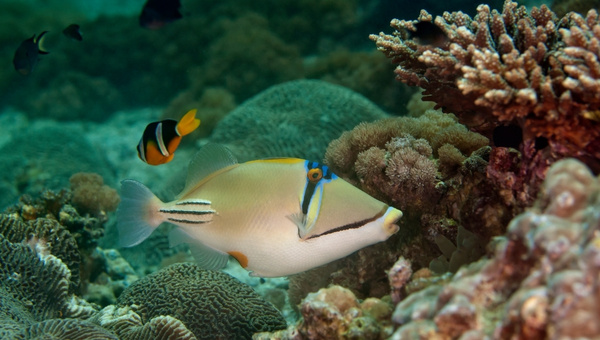
Some triggerfish have a “trigger” on their dorsal fin, which is used to lock the fish into place when it sleeps in a cave or crevice.
Triggerfish Size
Most triggerfish species reach a size of 6-14 inches, with a few species (like the Queen triggerfish) reaching up to 20 inches.
Triggerfish Lifespan
The average lifespan of a triggerfish is 10-15 years, with some species living up to 20 years.
Triggerfish Breeding
Triggerfish are difficult to breed in captivity. The best way to breed these fish is to keep a group of males and females together and let them spawn in a large aquarium with plenty of live rock for the fry to hide in.
Triggerfish Care Guide
Triggerfish are relatively easy to care for, but they do have some specific requirements. These fish need a large aquarium with plenty of hiding places. They should be fed a variety of foods, including live brine shrimp and frozen mysis shrimp.
Triggerfish are saltwater fish, so they must be kept in an aquarium with saltwater.
Triggerfish Minimum Tank Size
The minimum tank size for most triggerfish species is 50 gallons. However, larger species (like the Queen triggerfish) will need a minimum tank size of 100 gallons.
Triggerfish Water Requirements
The water conditions for triggerfish are relatively forgiving. They can tolerate a wide range of temperatures (72-78 degrees Fahrenheit is ideal), and they can live in both fresh and salt water. It is important to have a good filtration system in place, as triggerfish are messy eaters.
Triggerfish Tankmates
Triggerfish are not recommended for novice aquarists, as they can be aggressive toward other fish. They should only be kept with fish that are similar in size and temperament.
Triggerfish Habitat
Triggerfish are found in tropical and subtropical waters all over the world. They typically inhabit reefs and lagoons.
Triggerfish Food & Diet
Triggerfish are carnivores, and their diet consists mostly of crustaceans (like crabs and shrimp) and mollusks (like squid and octopus). They should be fed a variety of foods, including live brine shrimp and frozen mysis shrimp.
Triggerfish Common Possible Diseases
Some common diseases that can affect triggerfish include Marine Ich and Velvet. These diseases are typically caused by poor water conditions. It is important to maintain good water quality in the aquarium, as triggerfish are sensitive to changes in water quality.
- Prevention: The best way to prevent diseases in triggerfish is to maintain good water conditions and to quarantine new fish before adding them to the aquarium.
- Treatment: If triggerfish do become sick, they can be treated with a variety of medications, including copper-based medications and quinine. It is important to seek professional advice before treating any fish with medication.
Tips
Here are a few tips for keeping triggerfish:
- Keep triggerfish in an aquarium that is at least 50 gallons.
- Triggerfish are best kept with fish that are similar in size and temperament.
- Feed triggerfish a variety of foods, including live brine shrimp and frozen mysis shrimp.
- Maintain good water quality in the aquarium, as triggerfish are sensitive to changes in water quality.
- If triggerfish do become sick, seek professional advice before treating them with medication and follow the instructions carefully.
Triggerfish are beautiful and unique fish that can make a great addition to any aquarium. They are relatively easy to care for, but they do have some specific requirements. These fish need a large aquarium with plenty of hiding places.
They should be fed a variety of foods, including live brine shrimp and frozen mysis shrimp. Triggerfish are saltwater fish, so they must be kept in an aquarium with saltwater. If you are considering adding a triggerfish to your aquarium, be sure to do your research and choose a species that is right for your tank.
Summary
Saltwater fish can be the centerpiece of any room, and with so many different species to choose from, it’s hard to go wrong. But if you’re looking for the most popular saltwater fish, here are 17 that top the list.
It will be very rewarding as these fish can help you achieve a sense of peace and relaxation in your home.



